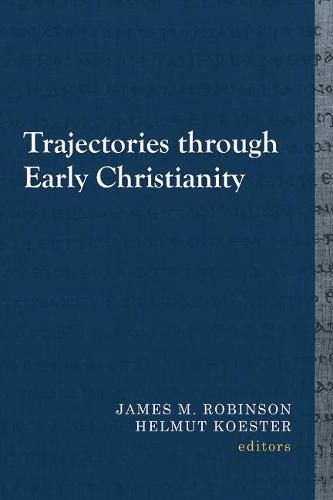Readings Newsletter
Become a Readings Member to make your shopping experience even easier.
Sign in or sign up for free!
You’re not far away from qualifying for FREE standard shipping within Australia
You’ve qualified for FREE standard shipping within Australia
The cart is loading…






This title is printed to order. This book may have been self-published. If so, we cannot guarantee the quality of the content. In the main most books will have gone through the editing process however some may not. We therefore suggest that you be aware of this before ordering this book. If in doubt check either the author or publisher’s details as we are unable to accept any returns unless they are faulty. Please contact us if you have any questions.
In the early ‘70s, James M. Robinson (Claremont) and Helmut Koester (Harvard), both students of Bultmann, broke new ground in their Trajectories through Early Christianity . The eight essays that comprise this volume seek a wholesale redefinition of the task of New Testament studies, as well as illustrating this newly conceived task. Robinson and Koester claim that the New Testament cannot be read apart from other early Christian literature and that the regnant designation of canon is misleading because it obscures the essential fluidity of early Christianity. Robinson and Koester not only question the artificial limits of the New Testament as a whole, but also the utility of the most commonly accepted forms ( Gattungen ) that constitute the New Testament. In the end, even the labels orthodoxy and heresy should be abandonedaalong with an outmoded belief that orthodoxy preceded heresy and formed the center of Christianity. From its birth, Christianity was pluriform, and what later came to be known as orthodoxy and heresy were only two of many equally legitimate trajectories running through Christianity. Robinson and Koester’s bold wrestling with the basic question of Christian origins proves as instructive today as it did over forty years ago: was there ever identifiable unity in early Christianity, or has diversity always been the measuring stick?
$9.00 standard shipping within Australia
FREE standard shipping within Australia for orders over $100.00
Express & International shipping calculated at checkout
This title is printed to order. This book may have been self-published. If so, we cannot guarantee the quality of the content. In the main most books will have gone through the editing process however some may not. We therefore suggest that you be aware of this before ordering this book. If in doubt check either the author or publisher’s details as we are unable to accept any returns unless they are faulty. Please contact us if you have any questions.
In the early ‘70s, James M. Robinson (Claremont) and Helmut Koester (Harvard), both students of Bultmann, broke new ground in their Trajectories through Early Christianity . The eight essays that comprise this volume seek a wholesale redefinition of the task of New Testament studies, as well as illustrating this newly conceived task. Robinson and Koester claim that the New Testament cannot be read apart from other early Christian literature and that the regnant designation of canon is misleading because it obscures the essential fluidity of early Christianity. Robinson and Koester not only question the artificial limits of the New Testament as a whole, but also the utility of the most commonly accepted forms ( Gattungen ) that constitute the New Testament. In the end, even the labels orthodoxy and heresy should be abandonedaalong with an outmoded belief that orthodoxy preceded heresy and formed the center of Christianity. From its birth, Christianity was pluriform, and what later came to be known as orthodoxy and heresy were only two of many equally legitimate trajectories running through Christianity. Robinson and Koester’s bold wrestling with the basic question of Christian origins proves as instructive today as it did over forty years ago: was there ever identifiable unity in early Christianity, or has diversity always been the measuring stick?